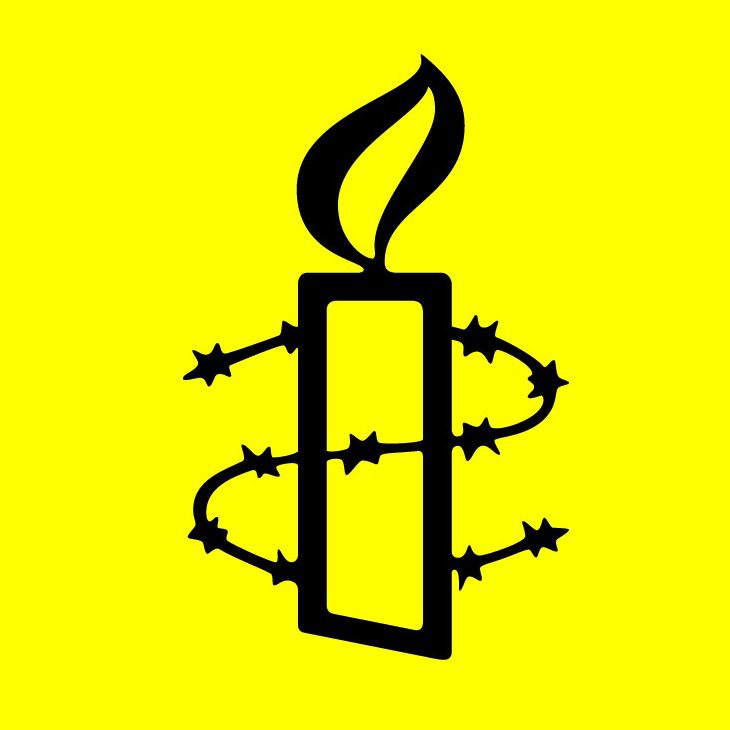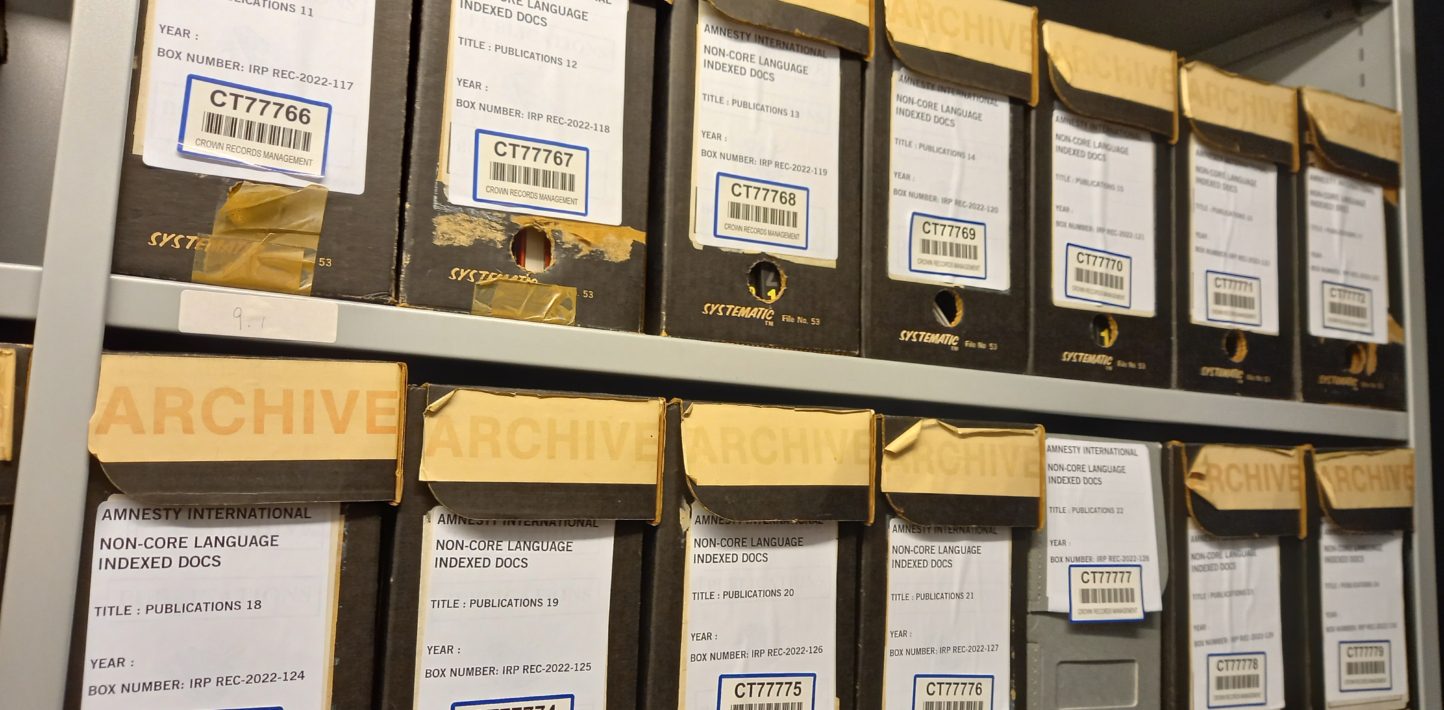As Amnesty International’s Archivist, I was delighted to be asked by the Crisis Evidence Lab to discuss the impact of vicarious trauma from an archive and recordkeeping perspective. Our archive holds the collective institutional memory of the Amnesty International – International Secretariat (AIIS), dating back to the organization’s foundation in 1961. The collection includes records related to the development of the organization, six decades of campaigns against human rights violations, and sensitive information on thousands of human rights defenders.
The impact of working with documents containing potentially traumatic content has historically not been particularly well understood or explored within the archives and recordkeeping sectors. Discussions around the subject have largely been informal, and traditionally not covered in academic courses. As archivists, we are often encouraged to think of ourselves as impartial. Our training teaches us to be neutral ‘custodians’ of records, and to leave their interpretation to the user. This has extended to the potential harmful effects of viewing traumatic content. Existing guidance is primarily geared towards how users of archives could be impacted, rather than archive workers.
However, the position of the neutral recordkeeper has been challenged in recent years, as archival documents have played key roles in truth and reconciliation commissions. In countries like South Africa and Canada, archival documents helped hold perpetrators of abuse accountable for their actions and victims obtain justice.
Existing guidance is primarily geared towards how users of archives could be impacted, rather than archive workers
One of the key functions of the archives and recordkeeping profession is to ensure the permanent preservation of evidence. This evidence could be in the form of a paper document, or an email or video, and could contain something as innocuous as a decision taken in a meeting, or as traumatic as a photograph of a torture victim. In my experience, archivists are often so concerned with assessing documents for these ‘evidential’ qualities that we have rarely stopped to assess the psychological consequences of viewing large quantities of distressing material. However, within the archival community in recent years, there has been a call to action to engage with this important aspect of our work more thoroughly.
One of the key functions of the archives and recordkeeping profession is to ensure the permanent preservation of evidence. This evidence could be in the form of a paper document, or an email or video, and could contain something as innocuous as a decision taken in a meeting, or as traumatic as a photograph of a torture victim.
Developments in the sector: a trauma-informed approach
In June 2023, I attended a talk led by Nicola Laurent and Kirsten Wright, both based at the University of Melbourne Find & Connect Project and members of the Australian Society of Archivists (ASA). Laurent and Wright have advocated extensively for organizations to adopt what they define as a ‘trauma-informed approach’ to managing archives, and for the sector to recognize the impact of vicarious or secondary trauma in archives as well as the emotional labour undertaken by archivists in their day-to-day work. This is clearly highly relevant to those working with human rights documentation, which is likely to contain distressing material. The AIIS archive, for example, contains detailed written survivor testimonies and case files as well as photographs of torture and murder, which can often be hidden innocuously inside paper files.
The aim of Laurent and Wright’s work has not been to “change what your organization does, but how it does it”. They have been involved in the creation of an online course and workshop on ‘implementing trauma-informed archival practice’ which encourages greater dialogue around how to approach archives containing traumatic material for both users and recordkeepers. As part of the talk, the results of a recent survey examining trauma in archives were discussed. The survey received around 1,000 responses in English, French and Spanish. The questions that were asked included:
- Is the potential for traumatic experiences in archives well understood?
- How widespread are experiences?
- What support is available?

The results of the survey can be viewed on the International Council on Archives website, and key findings included:
- 87% of respondents believed people can experience trauma when consulting archives.
- 68% of respondents had been exposed to content they found distressing or traumatic.
- 92% of respondents were not taught about these concepts as part of their academic education.
This work has now spread to other countries. The UK & Ireland Archives and Records Association has created Emotional Support Guidelines for archive workers. The Society of American Archivists have also compiled resources to support archivists working with traumatic content, while ASA have a page on their website about how to respond immediately after viewing traumatic content.
Suggested coping mechanisms include:
- Breathe slowly and deeply – try to concentrate on the feeling of your breath flowing in and out of your body.
- Ground yourself – put your feet on the floor and push them into the ground. Try and focus on the feeling of your feet being grounded on the floor.
- Remove yourself from the environment – go for a walk or sit outside in the fresh air.
- Complete a mindfulness exercise – if possible, find one in advance that you can refer to and are comfortable with.
- Take time to process what happened – reflect on what just occurred, rest and reset by thinking about what you want to happen going forward. This could be for 30 seconds, 30 minutes, or however long you need. You can find examples in advance which you can prepare to guide you through this process.
While research into the subject is still at an early stage, Laurent and Wright argue that trauma requires an organizational, rather than a personal response. They recommend that organizations formally recognize their responsibilities with regard to supporting their staff and that training is provided. Clear labelling and descriptions of content by record creators is a useful tool in preparing archivists for potentially traumatic encounters.

Other informal solutions have also emerged, like a trauma-informed archives ‘Community of Practice’. Established on Discord, the space allows professionals worldwide to share resources and discuss issues directly with their peers.
With more widespread acknowledgement that vicarious trauma can undoubtedly affect archivists and recordkeepers, organizations will be better placed to identify warning signs and support their staff appropriately. Upon joining Amnesty International in 2023, I was made aware of the support that was available to me in the form of a network of psychological first aiders, who have been trained in trauma-focused psychological first aid. They can provide peer support for colleagues who are displaying signs of psychological distress, or are potentially at risk of psychological harm. I would encourage anyone involved in open-source investigations or archive work to follow these steps and seek advice when encountering materials that could cause vicarious trauma.
Other blogs by the Evidence Lab on the issue of vicarious trauma, including Jenna Mayhew’s Vicarious Trauma Guide, published following Amnesty’s participation in Digital Verification Corps summit in Mexico City in September 2022 are available here.


